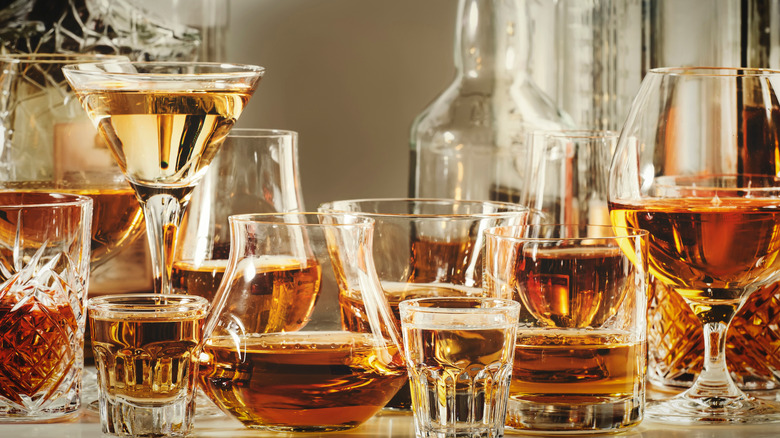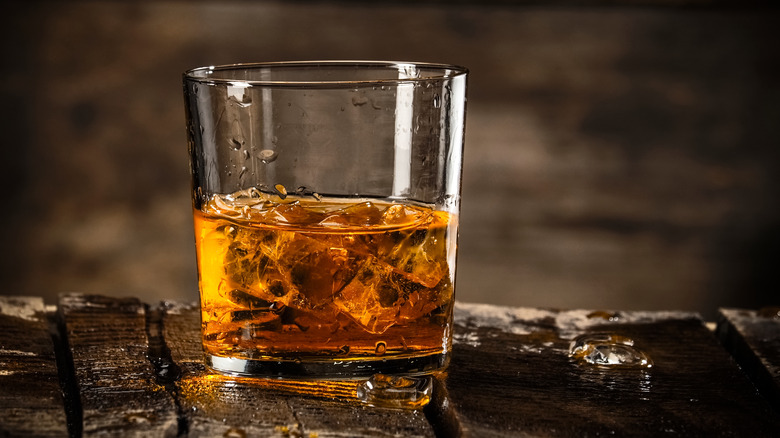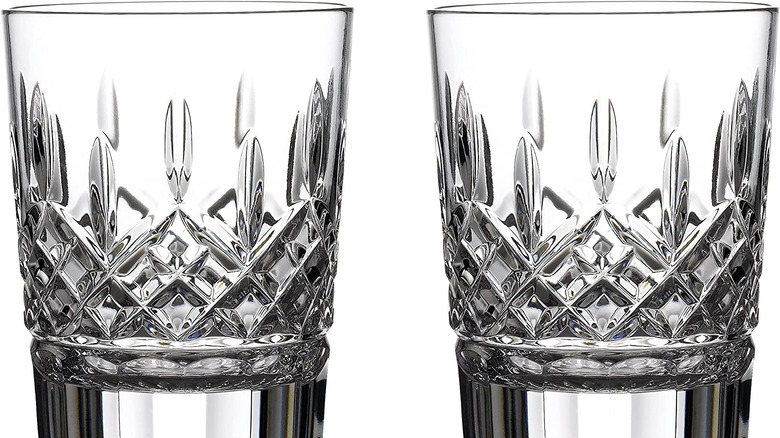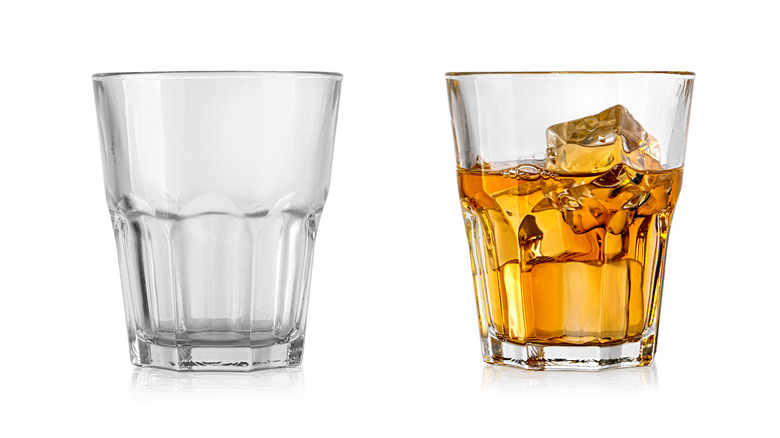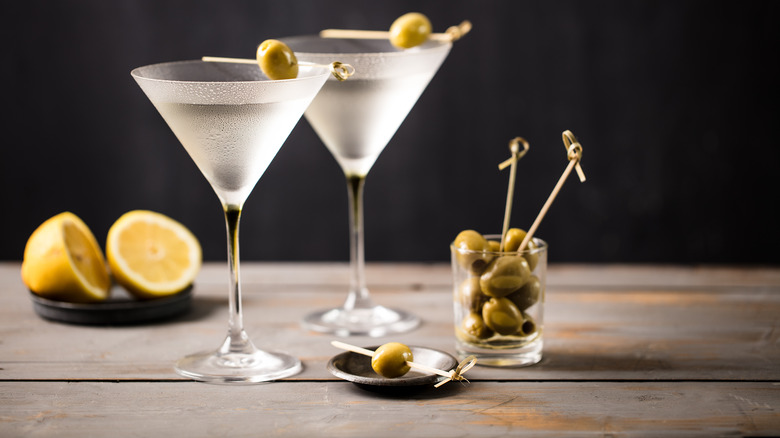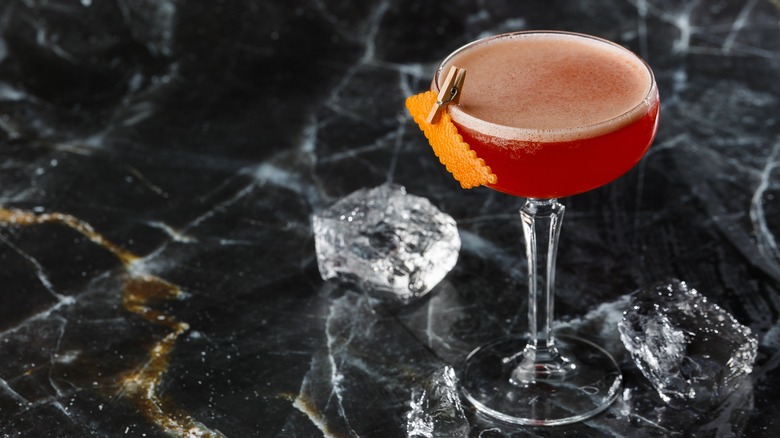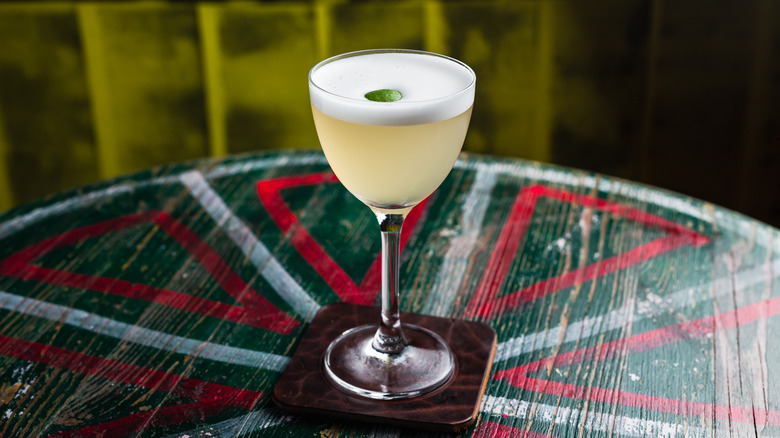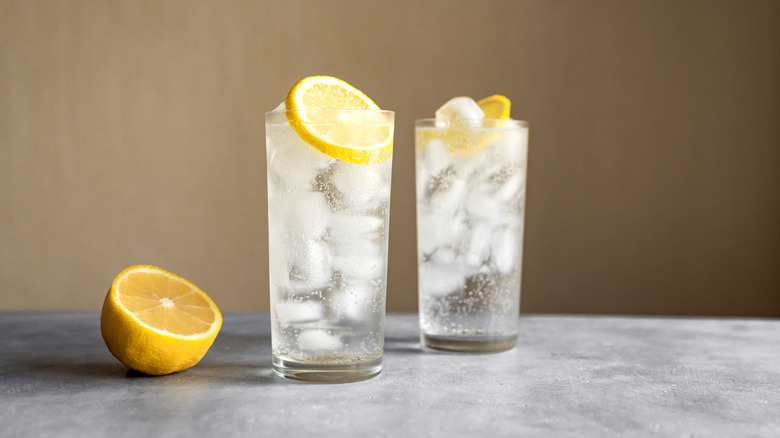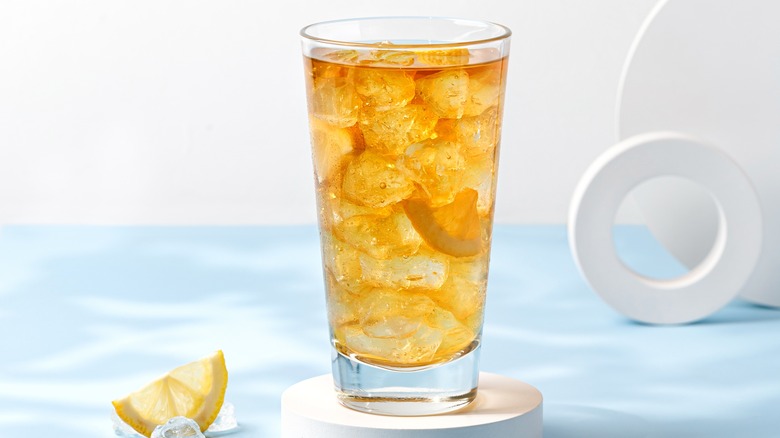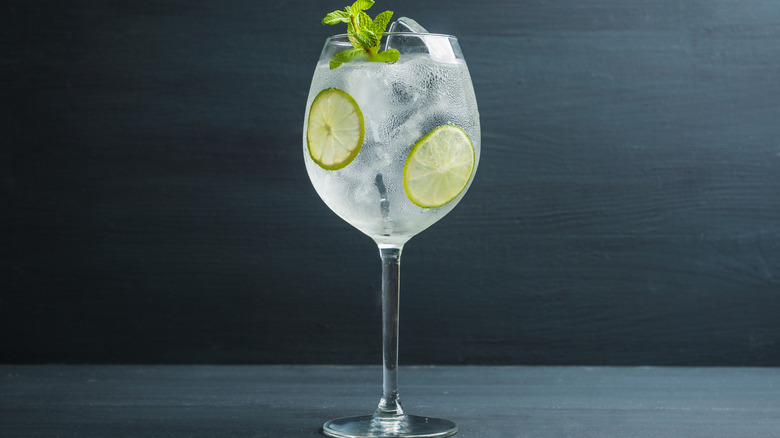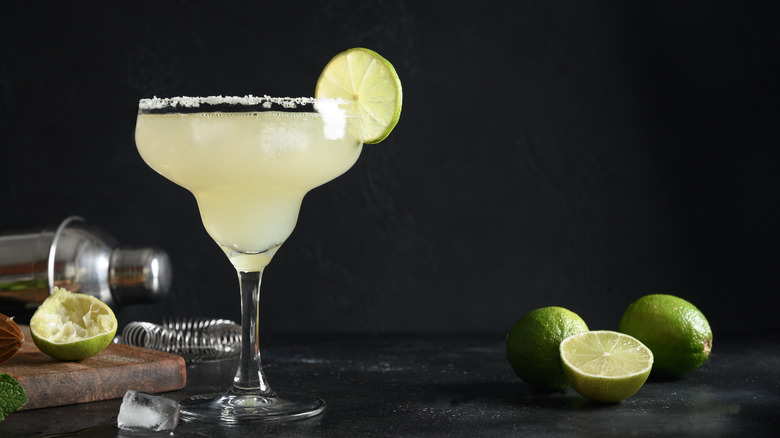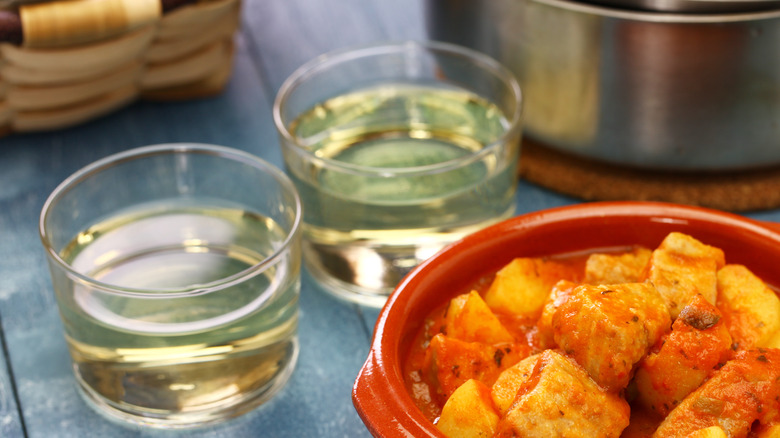11 Types Of Cocktail Glasses Explained
If you're trying to build a home bar, the variety of cocktail glasses available can be bewildering. Walk into a retail store or shop online and you'll find dozens of types, each with endless stylistic variations and geeky technical distinctions. The first thing to know is that form often follows function: Glasses with narrow openings can slow the dissipation of bubbles. Those with wide openings allow aromas to rise toward your nose. A glass with a flat base can support a big fat ice cube, while one with tapered shoulders is better to contain small cubes. There are even one-off glasses designed for a single drink, like a silver cup to hold a Mint Julep, a copper mug for a mule, or a tiki glass with a scowling face for a Zombie, which is indeed a scary drink.
Happily, to get going you can start with just a few types of cocktail glasses that can be used to make most of today's popular drinks. Then you can always add exotic glassware as you up your mixology game. Whether you're expanding your barware collection or starting from scratch, we've highlighted common types of cocktail glasses, with notes on what they're used for and why you may want to add them to your collection.
Old-fashioned glass
Dating back to 1806, the old-fashioned is the first beverage referred to in print as a cocktail. According to Difford's Guide, it was described as a mix of spirits, sugar, water, and bitters. The basic formula is still widely used today, with most cocktail bars serving the classic version using rye, simple syrup, and Angostura bitters in their go-to old-fashioneds. But several venues offer their own variations, tweaking the sweeteners and bitters and even the base spirit to create a signature beverage.
These days ice stands in for the water, which is why a proper old-fashioned glass is essentially a short cylinder with an open end and a flat bottom on which a jumbo cube can rest. The base also provides a surface that makes it easy to muddle sugar cubes or perhaps some basil or mint leaves.
Old-fashioned glasses can usually hold 6 to 8 ounces (via Home Wet Bar). But a classic old-fashioned cocktail, at slightly over 2 ounces, will hardly pass the halfway mark, the liquid coming no higher than halfway up the glass, its ice poking just above the surface.
Double old-fashioned glass
The name is a trick! The double old-fashioned glass, which is also referred to as a DOF, isn't twice as big as its standard-sized counterpart — it's more like a glass-and-a-half. It can be used for, among other things, tiki drinks that use a lot of ice, but more often it's known for holding double shots of booze on the rocks — which may be what the term "double" refers to here. But that's speculation — the history of these things always gets hazy, since the people who follow cocktails closely have often been, well, drinking. A double old-fashioned glass is also big enough to contain a highball or generally any drink that includes plenty of ice, like a rum and Coke or mojito.
If you want to add old-fashioned glasses to your collection but can't decide what decide which size to choose, we suggest going small. You can always make a second round with the traditional version, but with a double old-fashioned glass you either risk overserving your guests (or yourself) or look like you're offering a skimpy cocktail.
Rocks glass
As you shop, you'll likely find rocks glasses on a store shelf. Technically speaking, these are similar to old-fashioned glasses, but with thicker walls. They may also have tapered sides. However, be aware that some glasses that carry the rocks label are actually old-fashioned glasses sold under a different name. For that matter, you may find the same glasses sold as lowballs. Maddeningly, the three names are often used interchangeably in retail settings, though technically each is distinct (via Common Man Cocktails).
Rocks glasses are ideal for drinks for straight-booze drinks, like straight whiskeys or Scotches (via Vinepair). These also include some delicate gins, like Hendrick's and reposado (slightly aged) tequila. Ice adds a bit of water to a drink, which bartender Brandon McDonald told Chilled Magazine, can "take some of the burn away" from the beverage. For cocktails, an old-fashioned fits the bill, or give that reposado a boost and stir up a Restraining Order which marries the tequila with Aperol, celery bitters, and an orange twist.
One thing to look out for: Rocks glasses with tapered sides and a narrower bottom can be an awkward setting for a drink with a single fat hunk of ice, so if you want to go big with your cubes, an old-fashioned glass is a better bet.
Martini glass
The elegant taper of the martini glass, an olive cocked across its bow, is a visual synonym for the word "cocktail." While the invention of the glass followed the creation of the drink itself by more than 50 years, the Deco-style vessel achieved iconic status during and after Prohibition (via Imbibe).
The long, slim stem both elevates the conical bowl beautifully and allows a grip that keeps the fingers off the frosted sides, where they might warm the drink. And while it's been said that the wide surface area of the martini glass allows the aromas of a fine gin to reach the nose better than other glass designs, Cook's Illustrated debunked that theory in 2020 tests. They did determine that Martini glasses spill their contents quite easily, however, which anybody wobbly after their first martini has likely observed during round two.
Speaking of overserving: Like many cocktail glass designs, and the cocktails they hold, the martini glass has expanded over the years. Originally made to hold 4 ounces (via Los Angles Times), the martini glass has gone big. That happy hour apple-tini probably delivers 6 or 7 ounces of liquid, most of it booze. As they might put in the fine print: Please drink from that martini glass responsibly.
Coupe glass
The beautiful coupe (pronounced like the chicken house) is one of the most popular glasses in craft cocktail bars today (via Bevvy). Why? First, the shallow, elevated bowl is perfect for drinks served up, which is to say without ice. And that style of elixir is very popular among the sleeve-tattooed guys and gals behind the bar.
It usually holds no more than 4 ounces, allowing a smaller serving of liquor to look like a full glass. It doesn't slosh its contents onto the floor as easily as a Martini does. And it displays those clever garnishes oh-so-cleverly.
Debuting in 17th century England (via Chic and Tonic), it was originally used to serve Champagne, though that's less true now: Its broad surface allows bubbles to dissipate quickly. (You'll still find sparkling beverages served in coupes at weddings, but that may be because coupes can be stacked into those photogenic, perilous pyramids. Outside those celebrations, most sparking drinks are now served in tall, narrow flutes to keep the bubbles alive longer.)
Coupes are great choices for a home bar, as they'll work well with virtually any drink served without ice: margaritas, sours, negronis, Manhattans, after-dinner cocktails like a Brandy Alexander, and even ... wait for it ... martinis. They can make anything poured from your shaker or mixing glass look elegant and sophisticated.
Nick & Nora glass
Created at the direction of cocktail legend Dale Degroff, the Nick & Nora glass debuted in 1987 in New York City's Rainbow Room, where Degroff launched the cocktail program that in turn launched the classic cocktail renaissance that continues to this day ( via Vinepair). Dissatisfied with the huge and gaudy glasses of the 1980s, Degroff sought a smaller, more elegant vessel of the sort he imagined Nick and Nora Charles, the impossibly dashing crime-solvers in Dashiell Hammett's "The Thin Man" might use. A New York glassmaker designed one for him, and a modern legend was born.
Like the coupe, the Nick & Nora is a stylish stage for any drink that needs no ice. It elevates and embraces its contents and supports a modest garnish. It also works very well for aperitifs, liqueurs, vermouths, and other single-spirit sippers. You can even serve wine in them for a fashionable look.
Collins glass
This cool, tall number is, of course, perfect for the eponymous Tom Collins cocktail (gin and fresh lemon with some sugar, topped with tonic), a concoction born in England during the late 1800s (via Spirits Beacon).
You can also use it to serve a John Collins, of course, along with its numerous cousins such as a Pedro Collins, a Pierre Collins, a Captain Collins, or Colonel Collins. (All are obscure riffs on the basic mixture of a base spirit, a citrus juice, a sweetener, and fizzy water.)
In fact, this simple vessel can handle basically any cocktail that calls for a lot of ice and a straw, or whose recipe says it should be "served long" (mean, a significant portion of mixer is added to the equation). You can also use this glass to enjoy mojitos, Tiki creations like Zombies and Singapore Slings, or, when you're feeling brave, Long Island iced teas (via Cocktail Emporium).
Highball glass
Very similar to a Collins glass, a highball is slightly shorter and may have flared sides (via Liquor.com). It's traditionally been used for mid-century classics like Scotch and soda or, more recently, the ubiquitous vodka tonic.
With highball glasses, size matters. Let's start with the recipe: A typical highball is a two-ingredient beverage, consisting of a base spirit (like whiskey, Scotch or rum) and a mixer (like soda, ginger ale or cola). It's usually 2 to 3 ounces of booze to 4 to 6 ounces of mixer. At the low end that's 6 ounces of liquid, at the high end 9 ounces. Yet you'll find highball glasses with a capacity as low as 8 ounces. That'll leave you precious little room for ice — a key ingredient in a glass that's held directly in the hand. That glass should be packed with ice so nothing floats. Best to opt for the 10- to 12-ounce products.
Balloon glass
These lovely glasses are showing up in more bars and restaurants, as cocktail stylists move iced drinks into these spherical vessels. Balloon glasses offer many advantages: They make drinks look huge, provide volume for plenty of ice, offer a stem for easy handling, and display colors and garnishes to great effect.
Developed by the Spanish and also known as Copa glasses, balloons look a lot like red wine glasses. Spanish chefs adopted them for gin and tonics (via Gin Observer). Because they have wide bowls and narrow openings, they retain the bubbles of drinks topped with seltzer or soda, like mojitos. In hands-on tests, BBC's Good Food found the globes conveyed the delicate botanical aromas of gin better than other glassware they tested.
Bonus: These are perfect glasses for serving red wine. In other words, you can buy these as your red wine glasses and they'll double as perfect vessels for your gin and tonics along with many other boozy creations.
Margarita glass
This is one of those single-purpose drink glasses that risks crowding your cabinets. But if the classic mix of tequila, lime juice, and Cointreau lubricates your wheelhouse, it may be worth the pinch.
According to Margaritaville, these weren't intended to be the glass of choice for the classic Mexican cocktail. Legend has it that the pairing was the result of a botched shipment of Champagne glasses to a Los Angeles restaurant. When these oddly-shaped vessels arrived instead, the bartender figured they'd be well-suited for a margarita, and the rest is history.
The good news — and the bad news — is that most margarita glasses are huge, with a capacity of 10 to 14 ounces and beyond. That means you'll be serving doubles, at least, to make them look more than half-full. Which brings us to a cultish variation on the recipe known as Tommy's Margarita. The riff replaces Cointreau, which is 80 proof, with agave syrup, which is zero proof. It's bright and light and delicious — and best of all, nobody gets hurt.
Bodega glass
This is as simple a drinking glass as you can get, and maybe the most trendy. You'll find these low, stemless vessels with gently tapered sides in restaurants all over Italy and Spain (via The New York Times), and in of-the-moment bistros across the globe. These short, plain glasses are versatile and suitable for everything from a negroni to the classic Sazerac. The New York Times even suggests using them for milk or iced tea. Though bodega glasses aren't generally ideal for ideal wine, experts note that they're fine for chilled reds and txakolina, a Spanish sparkling white wine (via New York Magazine).
Bodega glasses are a particular favorite in the hospitality industry because they are durable, dishwasher-safe, and inexpensive. Plus they're stackable — an important factor if you've filled your cabinets with too much other lovely glassware, particularly sets of oddly-shaped vessels like martini and margarita glasses.
